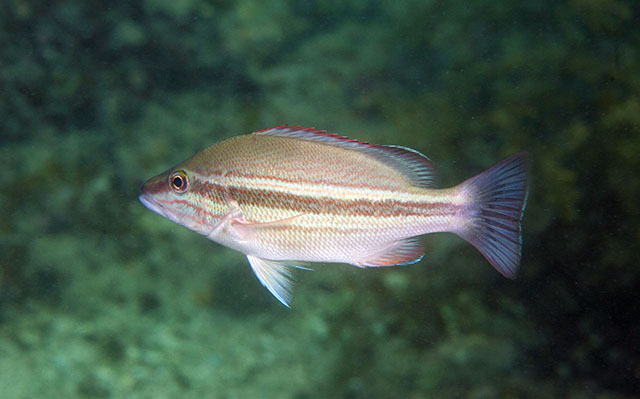| Lutjanidae (Snappers), subfamily: Lutjaninae |
| 65 cm TL (male/unsexed) |
|
reef-associated; marine; depth range 2 - 80 m |
| Western Indian Ocean: Mozambique (Ref. 41878). Indo-West Pacific: southern India and Sri Lanka to Philippines, New Guinea and Australia. Has been referred to as Lutjanus janthinuropterus and Lutjanus rangus (a junior synonym of Lutjanus bohar) by previous authors. |
|
Dorsal spines (total): 10-10; Dorsal soft rays (total): 13-14; Anal spines: 3-3; Anal soft rays: 8-8. Dorsal profile of head steeply sloped, snout profile slightly concave. Preorbital bone usually much greater than eye diameter, at least in large specimens. Preopercular notch and knob poorly developed. Scale rows on back rising obliquely above lateral line. Generally gray-brown or olive on the upper portion of the back and head, grading to whitish ventrally. The dorsal and caudal fins are dusky brown or black, frequently with a narrow white posterior margin. The anal, pelvic and pectoral fins are whitish with some dusky brown. Juveniles have a broad black horizontal band from snout tip to caudal fin base. Large juveniles with black mid-lateral stripe. Adults plain pinkish brown with dusky tail (Ref. 48635). Body depth 2.5-2.8 in SL (Ref. 90102). |
| Solitary or in small groups (Ref. 90102). Adults inhabit offshore reefs and muddy habitats. Juveniles are sometimes found in the vicinity of coral reefs, often located close to the shore where silting is moderate and visibility is reduced. Adults usually very deep (Ref. 48635). They feed on fishes and a variety of benthic invertebrates. |
|
Least Concern (LC); Date assessed: 28 June 2018 Ref. (130435)
|
| harmless |
|
Recorded from Raja Ampat Islands, Maumere Bay and Pulau Bintan; with an Indonesian distribution from Papua to Sumatra (Ref. 47567). Museum: LPPL JIF54, from southwest Sumatra to Timor Sea (Ref. 5978). Also Ref. 48635. |
Source and more info: www.fishbase.org. For personal, classroom, and other internal use only. Not for publication.

